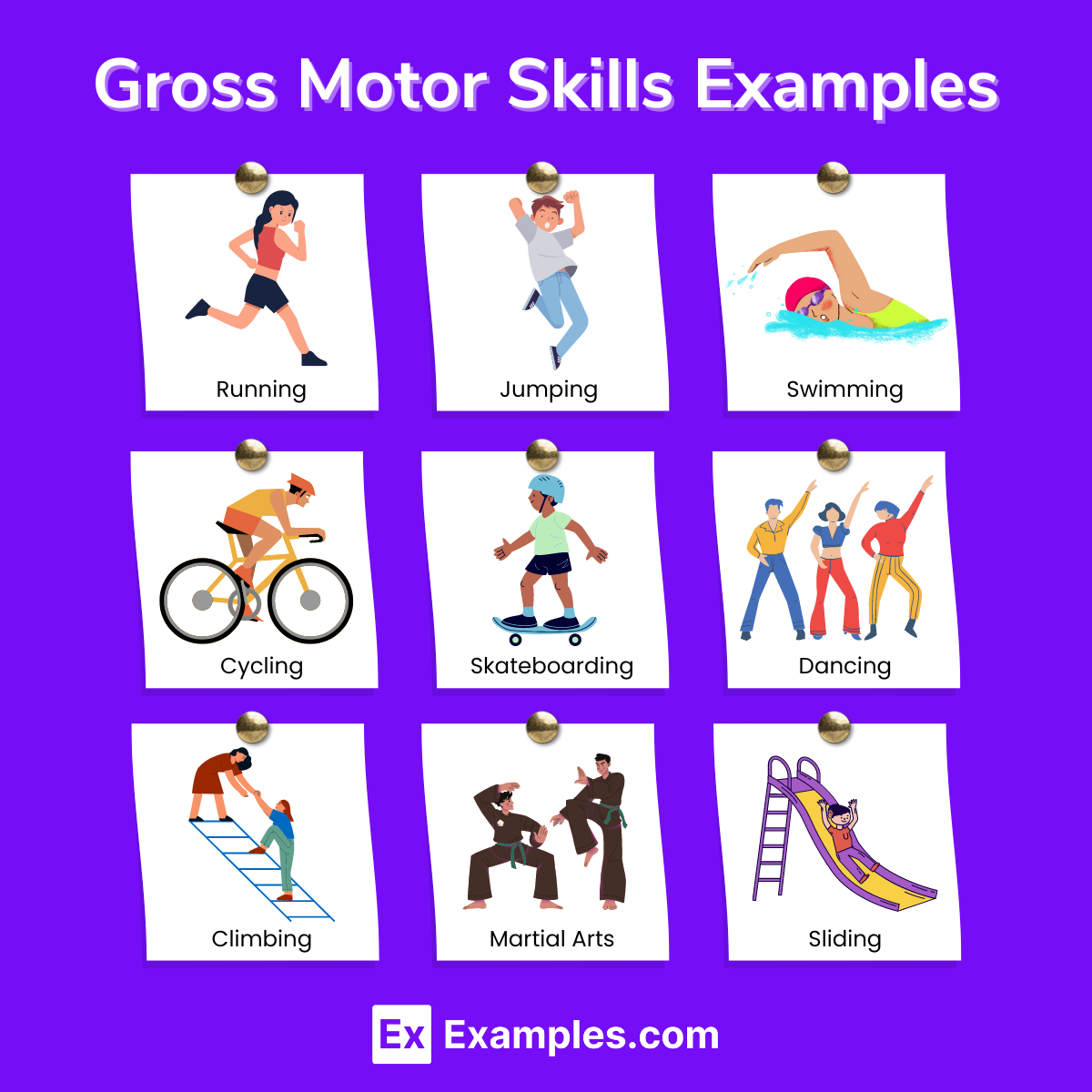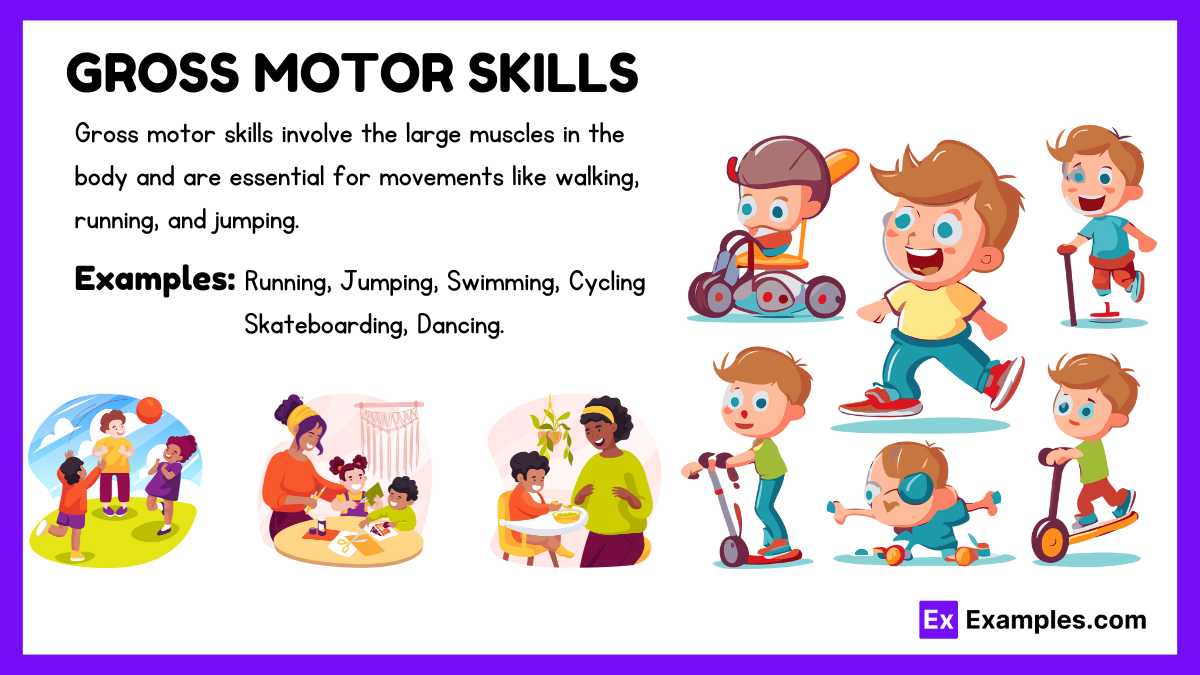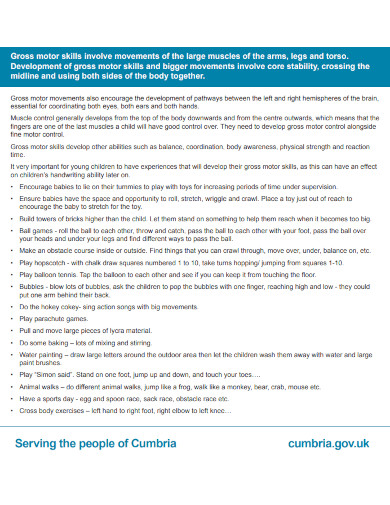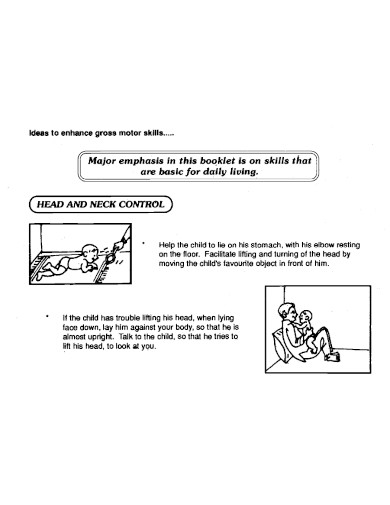10+ Gross Motor Skills Examples to Download
We all start somewhere, mostly when it comes to our physical abilities and exercises. One of the basic abilities and skills we have had to improve in the past is gross and fine motor skills. Each of these types of motor skills has its own specific range of movement and related limbs. Gross motor skills are essential for children’s physical development, involving large muscles for activities like walking, running, and jumping. These skills help children explore, play, and grow stronger. In this article, we will look at the basics of gross motor skills, important milestones, and ways to support their development in children.
What are Gross Motor Skills?
Gross motor skills involve the use of large muscles in the body to perform activities that require whole-body movement. These skills are essential for activities such as walking, running, jumping, climbing, and maintaining balance and coordination. Gross motor skills develop through childhood and are crucial for daily functioning and physical activities.
Gross Motor Skills Examples

For Adolescence (Ages 12-18)
- Running: Ability to run at varying speeds and distances.
- Jumping: Performing high jumps or long jumps.
- Swimming: Efficient swimming strokes and techniques.
- Cycling: Riding a bicycle, including maneuvering and balancing.
- Skateboarding: Balancing and performing tricks on a skateboard.
- Dancing: Coordinated dance moves requiring agility and balance.
- Playing Sports: Skills in sports like soccer, basketball, or tennis.
- Weightlifting: Lifting weights with proper form and technique.
- Climbing: Rock climbing or wall climbing with agility and strength.
- Martial Arts: Practicing martial arts forms and techniques.
For Preschoolers (Ages 3-5)
- Hopping: Hopping on one foot and then the other.
- Skipping: Alternating steps with a hop in between.
- Balancing on One Foot: Standing on one foot for several seconds.
- Throwing a Ball: Throwing a ball with coordination.
- Catching a Ball: Catching a thrown ball with both hands.
- Kicking a Ball: Kicking a ball towards a target.
- Climbing Stairs: Climbing stairs using alternating feet.
- Pedaling a Tricycle: Coordinating pedaling and steering a tricycle.
- Swinging: Pumping legs to swing on a playground swing.
- Jumping Over Objects: Jumping over small objects or obstacles.
For Kindergarten (Ages 5-6)
- Running: Running with improved speed and endurance.
- Jump Rope: Skipping rope individually or in a group.
- Balancing on a Beam: Walking across a balance beam without falling.
- Throwing with Accuracy: Aiming and throwing a ball at a target.
- Hopping on One Foot: Hopping on one foot for an extended period.
- Catching a Smaller Ball: Catching smaller balls like tennis balls.
- Skipping with Coordination: Coordinated skipping for longer distances.
- Galloping: Galloping with one foot leading consistently.
- Climbing Playground Equipment: Climbing various playground structures.
- Sliding: Sliding down slides with confidence and control.
For 2 Year Old’s
- Running: Running with improved stability.
- Jumping in Place: Jumping with both feet leaving the ground.
- Kicking a Ball: Kicking a stationary ball.
- Walking Backwards: Walking backwards without losing balance.
- Climbing Onto Furniture: Climbing onto and off of furniture.
- Throwing a Ball: Throwing a ball overhand.
- Dancing to Music: Simple dance moves to music.
- Squatting: Squatting to pick up objects and standing back up.
- Riding a Push Toy: Riding a push toy or ride-on toy.
- Stepping Over Obstacles: Stepping over small obstacles on the ground.
For Adults
- Running: Running for fitness or competition.
- Swimming: Swimming for fitness or recreation.
- Cycling: Cycling for fitness, commuting, or recreation.
- Weightlifting: Engaging in weightlifting or resistance training.
- Yoga: Practicing yoga poses and sequences.
- Hiking: Hiking on various terrains.
- Dancing: Participating in dance classes or social dancing.
- Playing Sports: Engaging in recreational or competitive sports.
- Aerobics: Performing aerobic exercises or attending classes.
- Gardening: Engaging in physical activities related to gardening.
For Infants (0-1 Year)
- Lifting Head: Lifting head while on tummy.
- Rolling Over: Rolling from tummy to back and back to tummy.
- Sitting Up: Sitting up without support.
- Crawling: Crawling on hands and knees.
- Pulling to Stand: Pulling up to stand using furniture.
- Cruising: Walking while holding onto furniture.
- Walking with Support: Walking while holding onto adult hands.
- Standing Alone: Standing without support for a few seconds.
- Reaching for Objects: Reaching and grabbing objects.
- Kicking Legs: Kicking legs while lying on back or tummy.
For Toddlers (Ages 1-3)
- Walking Independently: Walking without support.
- Running Short Distances: Running with improved balance.
- Climbing: Climbing onto furniture and playground equipment.
- Jumping with Both Feet: Jumping forward with both feet.
- Throwing Balls: Throwing balls with increased accuracy.
- Kicking Balls: Kicking balls with more force.
- Walking Up Stairs: Walking up stairs with support.
- Pulling Toys: Pulling toys while walking.
- Dancing: Dancing to music with basic movements.
- Pedaling Tricycles: Beginning to pedal tricycles.
For Early Childhood (Ages 3-8)
- Running: Running with greater speed and agility.
- Jumping Over Obstacles: Jumping over larger obstacles.
- Skipping: Skipping with rhythm and coordination.
- Hopping: Hopping on one foot for longer periods.
- Balancing: Balancing on a beam or one foot.
- Climbing: Climbing playground equipment or trees.
- Throwing with Aim: Throwing objects at targets with accuracy.
- Catching Smaller Balls: Catching smaller and faster balls.
- Riding a Bicycle: Riding a two-wheeled bicycle.
- Swimming: Swimming with proper strokes and breathing techniques.
What’s the difference between gross and fine motor skills?
| Aspect | Gross Motor Skills | Fine Motor Skills |
|---|---|---|
| Definition | Involve large muscle movements | Involve small muscle movements |
| Muscles Used | Large muscles of the arms, legs, torso | Small muscles of the hands, fingers, wrists, and face |
| Examples of Activities | Walking, running, jumping, climbing, throwing, kicking | Writing, buttoning a shirt, using scissors, drawing |
| Developmental Milestones | Crawling, standing, walking, jumping, balancing | Grasping objects, picking up small items, manipulating objects |
| Coordination | Requires coordination of large muscle groups | Requires precise and coordinated movements of small muscles |
| Typical Development Age | Develops early in infancy and continues to improve through childhood | Develops later in infancy and continues to refine through early childhood |
| Impact on Daily Activities | Affects activities like playing sports, moving around, and performing large movements | Affects activities like writing, eating with utensils, dressing, and other detailed tasks |
Why are gross motor skills important?
- Physical Health: Gross motor skills involve the movement and coordination of large muscles in the body. Activities like running, jumping, and throwing help children develop strong muscles and bones, improve cardiovascular health, and maintain a healthy weight.
- Coordination and Balance: Developing gross motor skills enhances coordination and balance, which are crucial for performing everyday activities safely and efficiently, such as walking, climbing stairs, and riding a bike.
- Cognitive Development: Engaging in physical activities that develop gross motor skills also stimulates brain development. These activities can improve concentration, memory, and problem-solving skills.
- Social Interaction: Many gross motor activities are social in nature, such as playing team sports or games. These activities help children learn teamwork, cooperation, and social norms, contributing to better social skills and relationships.
- Confidence and Independence: Mastering gross motor skills can boost a child’s confidence and self-esteem. It also promotes independence as children are able to perform tasks and explore their environment more effectively.
Stages of Gross Motor Development
- Infancy (0-1 year):
- Lifting head and chest while lying on the stomach
- Rolling over
- Sitting without support
- Crawling
- Pulling to stand
- Walking with support
- Toddler (1-3 years):
- Walking independently
- Running
- Climbing stairs with assistance
- Kicking a ball
- Throwing a ball
- Preschool (3-5 years):
- Running with more coordination
- Jumping with both feet
- Hopping on one foot
- Climbing stairs independently
- Pedaling a tricycle
- School Age (5+ years):
- Skipping
- Galloping
- Catching and throwing with accuracy
- Participating in organized sports and physical activities
Types of Gross Motor Skills
- Locomotor Skills: These skills involve the movement of the body from one location to another. They are fundamental for mobility and include actions such as moving forward, backward, or sideways. These skills are crucial for navigating the environment and play a significant role in activities like walking, running, and jumping.
- Non-Locomotor Skills: These skills involve movement that does not result in traveling from one place to another. Instead, they involve movement of the body while remaining in a stationary position. These skills are essential for flexibility, strength, and coordination and include actions like bending, stretching, and twisting.
- Manipulative Skills: These skills involve the handling and control of objects using various body parts. They require fine motor control and coordination between the hands and eyes or feet and eyes. These skills are important for tasks that involve throwing, catching, and striking.
- Stability Skills: These skills focus on maintaining body balance and control in various positions and movements. They are essential for activities that require maintaining equilibrium against the force of gravity. Stability skills include actions related to balancing, dodging, and landing.
1. Developing Gross Motor Skills
2. Enhancing Gross Motor Skills
3. Activities to Develop Gross Motor Skills
4. Indoor Gross Motor Skill Challenges
How to Improve a Child’s Gross Motor Skills
There are many ways and activities you can apply to improve the motor skills of a child. If you want to learn more about how to improve or enhance your child’s gross motor skills you can read up on any of the templates and assessment forms on the links above.
Step 1: Research Any Activities That Are Age-Appropriate for the Child
Begin by researching any activities or exercises that can be applied to the child you are going to train. You will need to ensure that the chosen activities and exercises are form fit for the child you will train.
Step 2: Create a Timeline of Activities for the Child
For training to be effective, you will need to ensure that the program is outlined in a specific schedule with rests in between. This will ensure that the training program or checklist is structured and properly applied.
Step 3: Apply the Timeline Consistently
You must ensure that the timeline you have set is applied consistently. This means you will need to follow a said timeline to a tee with all the applicable breaks.
Step 4: Observe Changes and Note Improvements
You must note down and observe any changes in performance and quality of skill in the activities and exercises you have applied. These will tell you of the quality of the timeline and exercises you have applied to your child.
Gross motor Delay Causes
Genetic and Congenital Factors
- Genetic Disorders: Conditions such as Down syndrome, Fragile X syndrome, and muscular dystrophy can impact motor development.
- Congenital Conditions: These include cerebral palsy, spina bifida, and congenital heart defects.
Neurological Issues
- Brain Injury: Injuries to the brain, either prenatally, perinatally, or postnatally, can affect motor skills.
- Neurodevelopmental Disorders: Autism spectrum disorder (ASD) and attention-deficit/hyperactivity disorder (ADHD) can impact motor development.
Environmental Factors
- Lack of Stimulation: Insufficient physical activity or opportunities for movement can delay motor skill development.
- Malnutrition: Poor nutrition can affect overall growth and muscle development.
- Socioeconomic Factors: Limited access to healthcare and developmental resources can contribute to delays.
Medical Conditions
- Chronic Illnesses: Conditions like congenital heart disease, respiratory disorders, or prolonged hospitalizations can impede motor development.
- Musculoskeletal Issues: Conditions such as clubfoot or hip dysplasia can restrict movement and delay gross motor skills.
Prematurity
- Preterm Birth: Babies born prematurely may have underdeveloped muscles and nervous systems, leading to delays in gross motor skills.
Sensory Impairments
- Visual or Hearing Impairments: Sensory deficits can impact the development of coordination and balance, essential for gross motor skills.
Developmental Coordination Disorder (DCD)
- Dyspraxia: This condition affects the ability to plan and coordinate physical movement, leading to delays in gross motor skills.
Infections and Illnesses
- Severe Infections: Infections such as meningitis or encephalitis can damage the brain and nervous system, affecting motor development.
- Chronic Conditions: Ongoing health issues, such as respiratory or gastrointestinal disorders, can impede physical development.
Other Factors
- Toxins and Exposure: Exposure to toxins (like lead) or prenatal exposure to alcohol or drugs can affect motor development.
- Psychosocial Factors: Emotional and psychological factors, such as trauma or neglect, can also play a role in motor development delays.
Key Aspects of Gross Motor Skill Function
- Movement and Coordination:
- Walking: Coordination of leg and foot movements.
- Running: Balance and speed control.
- Jumping: Strength and coordination for lifting off the ground.
- Climbing: Using both arms and legs in coordination.
- Posture and Balance:
- Sitting: Ability to maintain an upright posture.
- Standing: Balance and stability on two feet.
- Crouching: Balance and muscle control while bending knees.
- Strength and Endurance:
- Lifting and Carrying: Using muscles to lift objects and sustain the activity.
- Pushing and Pulling: Applying force to move objects.
- Sustained Activity: Ability to perform activities like running or climbing for extended periods.
- Coordination of Movements:
- Bilateral Coordination: Using both sides of the body together.
- Crossing the Midline: Moving a limb across the center of the body to perform tasks.
What are gross motor skills?
Gross motor skills involve large muscle movements like walking, jumping, and running. They are essential for overall physical development and daily activities.
Why are gross motor skills important?
Gross motor skills are crucial for coordination, balance, and strength. They enable children to perform everyday tasks and engage in physical play.
How can I improve my child’s gross motor skills?
Encourage activities like climbing, playing sports, dancing, and swimming. These help build strength, coordination, and balance.
What are examples of gross motor skills?
Examples include crawling, walking, running, jumping, throwing, and climbing. These activities use large muscle groups.
At what age do gross motor skills develop?
Gross motor skills begin developing in infancy and continue to improve throughout childhood, with significant milestones in early years.
How do gross motor skills affect learning?
Good gross motor skills support academic learning by enhancing focus, coordination, and the ability to sit still and concentrate.
What causes delays in gross motor skills?
Delays can be caused by genetic factors, neurological disorders, lack of physical activity, or developmental issues.
How are gross motor skills assessed?
They are assessed through observation and standardized tests, measuring a child’s ability to perform age-appropriate physical tasks.
What activities promote gross motor skills?
Activities like obstacle courses, ball games, bike riding, and playground play promote the development of gross motor skills.
Can therapy help improve gross motor skills?
Yes, physical therapy can help children improve gross motor skills through targeted exercises and activities tailored to their needs.







